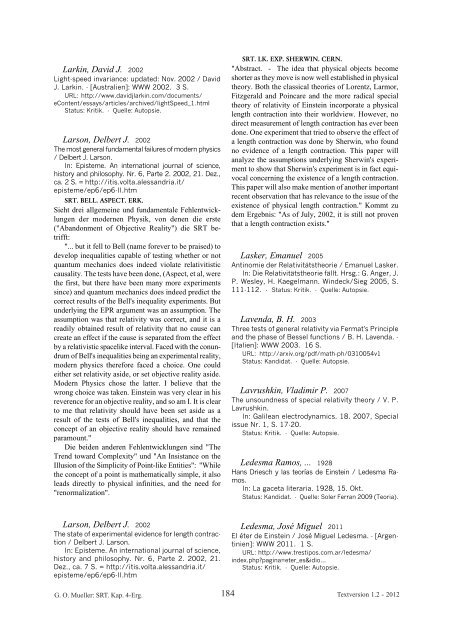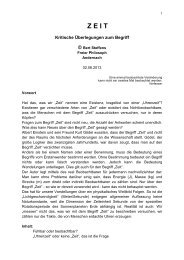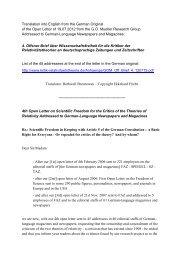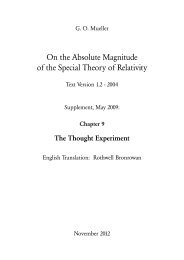2394 weitere kritische Veröffentlichungen - Kritische Stimmen zur ...
2394 weitere kritische Veröffentlichungen - Kritische Stimmen zur ...
2394 weitere kritische Veröffentlichungen - Kritische Stimmen zur ...
Erfolgreiche ePaper selbst erstellen
Machen Sie aus Ihren PDF Publikationen ein blätterbares Flipbook mit unserer einzigartigen Google optimierten e-Paper Software.
Larkin, David J. 2002<br />
Light-speed invariance: updated: Nov. 2002 / David<br />
J. Larkin. - [Australien]: WWW 2002. 3 S.<br />
URL: http://www.davidjlarkin.com/documents/<br />
eContent/essays/articles/archived/lightSpeed_1.html<br />
Status: Kritik. - Quelle: Autopsie.<br />
Larson, Delbert J. 2002<br />
The most general fundamental failures of modern physics<br />
/ Delbert J. Larson.<br />
In: Episteme. An international journal of science,<br />
history and philosophy. Nr. 6, Parte 2. 2002, 21. Dez.,<br />
ca. 2 S. = http://itis.volta.alessandria.it/<br />
episteme/ep6/ep6-II.htm<br />
SRT. BELL. ASPECT. ERK.<br />
Sieht drei allgemeine und fundamentale Fehlentwicklungen<br />
der modernen Physik, von denen die erste<br />
("Abandonment of Objective Reality") die SRT betrifft:<br />
"... but it fell to Bell (name forever to be praised) to<br />
develop inequalities capable of testing whether or not<br />
quantum mechanics does indeed violate relativitistic<br />
causality. The tests have been done, (Aspect, et al, were<br />
the first, but there have been many more experiments<br />
since) and quantum mechanics does indeed predict the<br />
correct results of the Bell's inequality experiments. But<br />
underlying the EPR argument was an assumption. The<br />
assumption was that relativity was correct, and it is a<br />
readily obtained result of relativity that no cause can<br />
create an effect if the cause is separated from the effect<br />
by a relativistic spacelike interval. Faced with the conundrum<br />
of Bell's inequalities being an experimental reality,<br />
modern physics therefore faced a choice. One could<br />
either set relativity aside, or set objective reality aside.<br />
Modern Physics chose the latter. I believe that the<br />
wrong choice was taken. Einstein was very clear in his<br />
reverence for an objective reality, and so am I. It is clear<br />
to me that relativity should have been set aside as a<br />
result of the tests of Bell's inequalities, and that the<br />
concept of an objective reality should have remained<br />
paramount."<br />
Die beiden anderen Fehlentwicklungen sind "The<br />
Trend toward Complexity" und "An Insistance on the<br />
Illusion of the Simplicity of Point-like Entities": "While<br />
the concept of a point is mathematically simple, it also<br />
leads directly to physical infinities, and the need for<br />
"renormalization".<br />
Larson, Delbert J. 2002<br />
The state of experimental evidence for length contraction<br />
/ Delbert J. Larson.<br />
In: Episteme. An international journal of science,<br />
history and philosophy. Nr. 6, Parte 2. 2002, 21.<br />
Dez., ca. 7 S. = http://itis.volta.alessandria.it/<br />
episteme/ep6/ep6-II.htm<br />
G. O. Mueller: SRT. Kap. 4-Erg.<br />
184<br />
SRT. LK. EXP. SHERWIN. CERN.<br />
"Abstract. - The idea that physical objects become<br />
shorter as they move is now well established in physical<br />
theory. Both the classical theories of Lorentz, Larmor,<br />
Fitzgerald and Poincare and the more radical special<br />
theory of relativity of Einstein incorporate a physical<br />
length contraction into their worldview. However, no<br />
direct measurement of length contraction has ever been<br />
done. One experiment that tried to observe the effect of<br />
a length contraction was done by Sherwin, who found<br />
no evidence of a length contraction. This paper will<br />
analyze the assumptions underlying Sherwin's experiment<br />
to show that Sherwin's experiment is in fact equivocal<br />
concerning the existence of a length contraction.<br />
This paper will also make mention of another important<br />
recent observation that has relevance to the issue of the<br />
existence of physical length contraction." Kommt zu<br />
dem Ergebnis: "As of July, 2002, it is still not proven<br />
that a length contraction exists."<br />
Lasker, Emanuel 2005<br />
Antinomie der Relativitätstheorie / Emanuel Lasker.<br />
In: Die Relativitätstheorie fällt. Hrsg.: G. Anger, J.<br />
P. Wesley, H. Kaegelmann. Windeck/Sieg 2005, S.<br />
111-112. - Status: Kritik. - Quelle: Autopsie.<br />
Lavenda, B. H. 2003<br />
Three tests of general relativity via Fermat's Principle<br />
and the phase of Bessel functions / B. H. Lavenda. -<br />
[Italien]: WWW 2003. 16 S.<br />
URL: http://arxiv.org/pdf/math-ph/0310054v1<br />
Status: Kandidat. - Quelle: Autopsie.<br />
Lavrushkin, Vladimir P. 2007<br />
The unsoundness of special relativity theory / V. P.<br />
Lavrushkin.<br />
In: Galilean electrodynamics. 18. 2007, Special<br />
issue Nr. 1, S. 17-20.<br />
Status: Kritik. - Quelle: Autopsie.<br />
Ledesma Ramos, ... 1928<br />
Hans Driesch y las teorías de Einstein / Ledesma Ramos.<br />
In: La gaceta literaria. 1928, 15. Okt.<br />
Status: Kandidat. - Quelle: Soler Ferran 2009 (Teoria).<br />
Ledesma, José Miguel 2011<br />
El éter de Einstein / José Miguel Ledesma. - [Argentinien]:<br />
WWW 2011. 1 S.<br />
URL: http://www.trestipos.com.ar/ledesma/<br />
index.php?pagina=eter_es&idio...<br />
Status: Kritik. - Quelle: Autopsie.<br />
Textversion 1.2 - 2012





